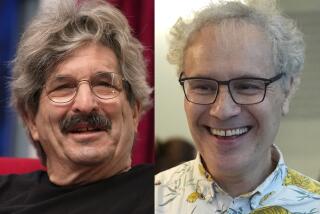Nobel Laureate’s String of Successes
Most scientists are fortunate to be involved in one major discovery during their lifetime. Sydney Brenner, who received the 2002 Nobel Prize in physiology or medicine, has been involved in at least three.
One, for which he received this year’s prize, was the idea to use the nematode Caenorhabditis elegans as an experimental subject to study the birth and death of cells in living organisms.
In the 1950s and 1960s, the La Jolla scientist played a key role in determining how the genetic information encoded in DNA was converted by cellular machinery into proteins. Working with molecular biologist Francis Crick--DNA’s co-discoverer--he deduced that the genetic information of DNA was encoded in triplets, groups of three chemicals that determined the identity of each amino acid in a protein. He also discovered messenger RNA, which is a key intermediary in converting genetic information into proteins.
More recently, he has advocated the use of the puffer fish, Fugu rubripes, as a model to study the human genome. The puffer fish has one of the most compact genomes known among vertebrates. Researchers studying it thus do not have to deal with the large quantities of so-called noncoding or extraneous DNA that are present in the human genetic blueprint.
Those are not bad achievements for the son of an illiterate Lithuanian cobbler.
Brenner was born in Germiston, South Africa, in 1927. He first developed an interest in biology from a book called “The Science of Life,” which he borrowed from a library then reported missing because he couldn’t afford to purchase it. Another influential book was “The Young Chemist,” which spurred him to buy chemicals from the local pharmacist and experiment in his garage.
At 14, he entered the University of the Witwatersrand in Johannesburg, intending to become a physician. He also met renowned paleontologist Raymond Dart, whom he often accompanied on digs to nearby Sterkfontein. Those experiences gave him a lifelong interest in anthropology, but he remained drawn to biology.
A fellowship took him to Oxford University, where Crick and James D. Watson were deciphering the structure of DNA. He quickly became friends with Crick, and the pair spent hours on end discussing scientific questions.
After he received his doctorate, he returned to South Africa, but his strong opposition to apartheid made the situation untenable and Crick helped him return to the Cavendish Laboratory at the Medical Research Council in Cambridge, where he spent the next 26 years. His work there on triplets and messenger RNA “might be his greatest achievement,” according to Roger Brent of the Molecular Sciences Institute in Berkeley.
Brenner played a key role in the 1974 Asilomar Conference in Pacific Grove, when molecular biologists gathered to consider the ethical implications of recombinant DNA and genetic engineering experiments that were just beginning in many laboratories. Many scientists feared that the experiments could unleash deadly and uncontrollable organisms.
Brenner strongly supported such research, but he argued at the conference that scientists should develop their own guidelines to regulate experiments before the government stepped in and preempted them. His arguments ultimately helped carry the day, and the conference marked one of the first times that researchers began independently regulating potentially dangerous experiments.
After retiring from Cambridge in 1992, he authored a paper in the journal Nature arguing for use of the puffer fish as a surrogate for the human genome. That paper has triggered a raft of new research. In 1998, he came out of retirement to help establish the Molecular Sciences Institute in Berkeley. He retired from there in 2000, only to come out of retirement again earlier this year to rejoin Crick at the Salk Institute for Biological Sciences in La Jolla.
As he said at the time: “I don’t want to retire to play golf. Science is one’s hobby and one’s work and one’s pleasure.”






